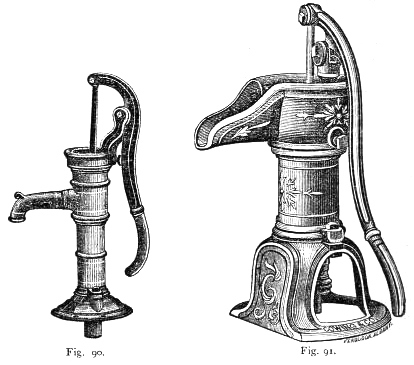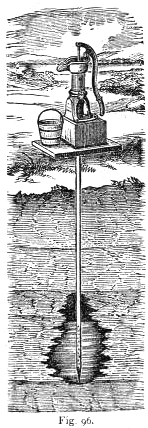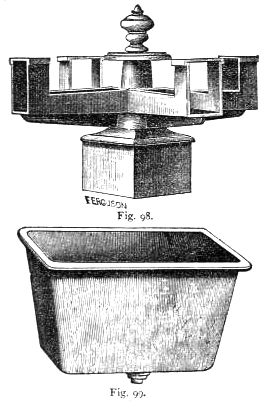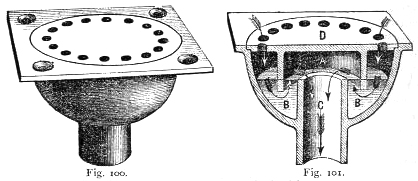
I found an interesting article regarding iron furniture (wells being the main concentration) in “The Illustrated Annual Register of Rural Affairs and Cultivator Almanac for the Year 1868,” Containing Practical Suggestions for the Farmer and Horticulturist by J.J. Thomas. There is an interesting article about the history of 19th century blacksmithing for context.
IRON FURNITURE FOR FARMS
“The Illustrated Annual Register of Rural Affairs and Cultivator Almanac for the Year 1868”
THE IMPROVEMENT which has been made in various kinds of farm fixtures and furniture of late years, is one of the distinct marks of modern progress. A cast-iron pig-trough, or iron manger, for example, will outlast a dozen made of wood, never need repairs, and are not liable to be gnawed and spoiled by animals. On this account they may be regarded as the most economical. Cast-iron cistern and well pumps work more easily and satisfactorily than the old heavy wooden ones, and are made and sold at low prices. There are several extensive manufactories of this iron furniture in different parts of the country — among which Cowing & Co., and Downs & Co., of Seneca Falls, N.Y., and J. D. West & Co., New York city, are conspicuous. Cowing & Co. have kindly furnished us with the several cuts for this article. As frequent inquiries are made, we shall doubtless render an acceptable service to our readers, by making them better acquainted with some of these iron articles, and inducing them to procure those superior to what they may have in some instances before possessed.

Pumps. — These are made of various forms, and for a large number of different purposes. Fig. 90 is an iron cistern-pump, showing the mode of bolting it to the floor or platform, and representing also their neat and compact form, occupying but little space at one side or in the corner of a kitchen over the cistern. Fig. 91 exhibits a new pump, of much simplicity and convenience, as we have proved by a full trial. The base is strongly braced, and yet is so short under the spout, that the water is delivered in the center of the pail, and dripping or slopping over the edge of the pail entirely prevented. The ease and rapidity with which it lifts and throws water, we have never found excelled. It is furnished with a contrivance for letting off the water from the tube at pleasure, to prevent freezing.

Although all the working parts of these pumps are made of iron, yet experience has proved that the cheapest, best and most satisfactory material for the tube, is wood. The Tulip tree or “White-wood,” is found well adapted to this purpose, and is used by Cowing & Co. When on a visit at their establishment, we found a lathe in operation of their own invention, which rendered three inch square scantling round and smooth, at the rate of eight feet in length per minute, the only attendance required being to lay the wood on the machine, and remove it when finished. It was then placed on another machine which bored these round sticks with accuracy and finish, at the rate of nine feet per minute — the chips flying out of the end, like chaff from the fanning mill. These wooden tubes are connected by means of iron couplings, which are shown in figs. 92 and 93. Fig. 94 shows a cast-iron fool valve, with strainer. Fig. 95 represents a cistern or well pump, so constructed that the working parts are about 20 inches below the platform or base of the pump, and are therefore well adapted for outdoor work. If the well or cistern is kept covered tight, the pump will not freeze below the platform. They will succeed in any well not over twenty feet deep, and by means of their various couplings may be made to draw water in a horizontal or inclined position, provided the whole height is not much over twenty feet.
Another form, is the engine well pump, adapted to deep wells and is made by combining the principles of atmospheric pressure, or suction, with the force pump, and having an air-chamber connected, will throw a constant stream. It is adapted to not only the ordinary uses of a well pump, but also to the washing of windows, buildings and vehicles, and the extinguishing of fires. With three feet of hose and a discharge pipe, water can be easily thrown over a two-story building, or with sufficient hose, carried over the entire premises.

Fig. 96 represents the new mode of making wells by simply driving into the earth common iron gas pipe, pointed at the lower end, and perforated at the sides near the lower extremity for the ingress of water — thus obviating entirely the cost and labor of digging wells. If driven through a subterranean spring, stratum of water, or a wet layer of sand or gravel, it is obvious that the water will immediately flow through the perforations into the pipe ; and by attaching a good pump to the pipe, and pumping for a time, all the particles of sand and fine gravel will be drawn out, and the cavity thus formed around the perforations will remain filled with pure water. These tubes and pumps are admirably adapted to localities where large beds of wet gravel exist fifteen or twenty-five feet below; and in fact to all soils where large stones are not abundant. Where these occur, the pipe must be withdrawn and tried in a new place, until success is attained.

An excellent deep well pump is represented by fig. 97 — the working part being placed at the bottom of the well, is adapted to any depth of water, the rod working safely within the cylinder. The lower part of the cylinder is furnished with a strainer which is plugged at the bottom to prevent the ingress of sand and mud. The connecting pipe between the cylinder at the bottom and the standard at the top, is wrought or galvanized iron. The pump of course needs bracing to prevent swinging when worked.

Other Iron Articles. — A clothes-line reel is shown in fig, 98, the arms being made of wood and inserted after the cast-iron or central part has reached its destination. The tight square cap, immediately below the reel, fits upon the top of a post set out of doors, conveniently accessible to the wash room.
Fig. 99 is a slop-sink which needs very little explanation. It will hold a common sized tub of water, and is furnished with a strainer and cesspool, forming a safety-valve to the drain when set upon it.

Figs. 100 and 101 represent the bell-traps alluded to, which prevent the entrance of impure gases or nausious affluvia into dwellings from sewers or drains. Fig. 101 is a section
showing the structure of different parts. The inverted bell A. comes below the top of the tube C. into the water B. and thus entirely confines the gas in the top of the inverted bell A. The arrows show the course of the water through the trap into the sewer or drain.

Cast-iron jack-screws, shown in fig. 102, are useful for many purposes, such as raising the corners or sides of buildings which have settled out of place, in renewing the under-pinning, &c. The nuts to these screws are made so as to let into a wooden block or timber.